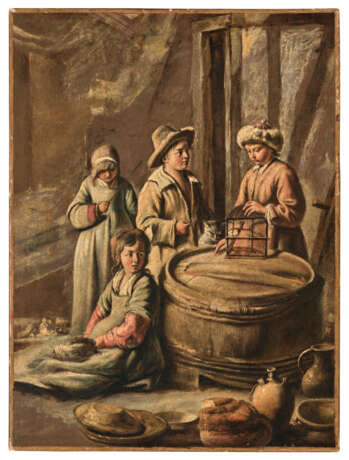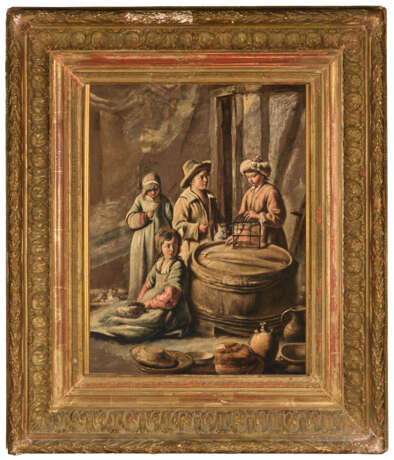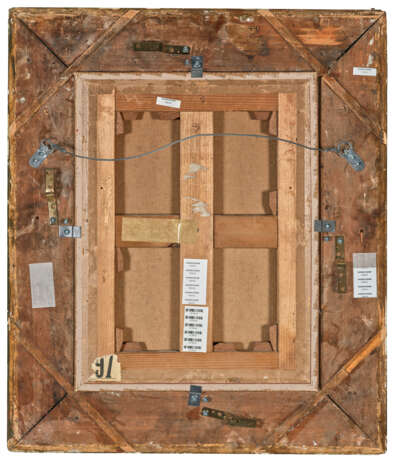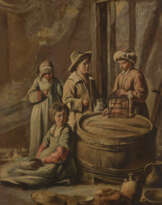ID 1336077
Los 24 | LES FRÈRES LE NAIN (LAON VERS 1588-VERS 1677 PARIS)
Schätzwert
€ 40 000 – 60 000
Les Enfants à la cage
huile sur toile
41,6 x 31,1 cm (16 3/8 x 12 ¼ in.)
Provenance
Dr. Hans Wendland (1880-1965), Lugano ; sa vente, Graupe, Berlin, 24-25 avril 1931, lot 56 (comme Louis Le Nain) ;
Acquis au cours de celle-ci par une collection particulière ;
Puis par descendance dans la famille ; vente anonyme, Christie's, New York, 27 janvier 2000, lot 174 (comme attribué à Mathieu Le Nain) ;
Acquis au cours de celle-ci par l'actuel propriétaire.
Literature
Internationale Sammler-Zeitung, 15 mai 1931, 23e année, 10, p. 110 (comme Louis Le Nain).
J. Thuillier, Les Frères Le Nain, [cat. exp.], Paris, 1978, p. 195, sous le n°31 (comme '[...] sa qualité semblait haute, et nous regrettons de n'avoir pu retrouver sa trace').
P. Rosenberg, Tout L'Oeuvre Peint Des Le Nain, Paris, 1993, p. 88, n°62B (comme '[une] version plus petite avec d'importantes variantes [du tableau de Karlsruhe]'), reproduit en noir et blanc.
P. Rosenberg, Poussin, Lorrain, Watteau, Fragonard..., [cat. exp.], Paris, 2005, p. 171, sous le n°86 (comme '[version] avec variantes').
N. Milovanovic, Les frères Le Nain : Bons génies de la sympathie humaine, Paris, 2019, p. 158, n°18 (comme 'nous pencherions pour le groupe "Louis" pour le tableau qui nous intéresse ici').
Further details
THE BROTHERS LE NAIN (C. 1588-C. 1677), CHILDREN WITH A CAGE, OIL ON CANVAS
The present composition stands out in the oeuvre of the Le Nain brothers (c. 1588-c. 1677) for the whimsy of its subject matter. The two brothers standing around the barrel contemplate an empty bird cage, whilst between them an uncharacteristically contrite cat is sitting, the implication being that the cat has succumbed to his feline nature and eaten the bird. Two versions of this composition are known, each with slight differences: the present painting, with its wonderfully dusky palette, and a second in the Staatliche Kunsthalle, Karlsruhe, which has a darker, more robust color scheme (inv. no. 2544). When François-Rolland Elluin (1745-1822) made an engraving after the Karlsruhe version he underlined the anecdotal nature of the painting by giving it the title Le Voleur pris – the captured thief.
In his 1978 exhibition catalogue, Jacques Thuillier (op. cit. p. 196) suggests that this choice of subject may place both paintings at the beginning of the brothers’ production, slightly before 1640. Imbued as they are with a great sense of calm, both paintings are a far cry from the contemporary popular burlesque prints that depicted children playing with animals. However, it is undoubtedly in this vein that they would have been understood, which suggests that were executed whilst the Le Nain brothers were still searching out the more detached, slightly haunting style that marked their later scenes of peasant life.
As well as the difference in color palette between the present painting and the Karlsruhe version, a number of other differences can be highlighted. Most importantly, the choice here to situate the scene inside the wonderfully ramshackle building, which helps to anchor the still-life elements at lower right. In contrast those in the German version float slightly awkwardly. The difference between the two paintings has naturally led to speculation as to which of the brothers might have painted which example.
Much time has been expended by scholars in trying to distinguish the hands of the artistic collective that were the Le Nain brothers, Antoine (ca. 1598-1648), Louis (ca. 1600/1605-1648) and Mathieu (ca. 1607-1677). They produced altarpieces and religious paintings; portraits; small, multifigural pictures of musicians or children, such as the present painting; and peasant scenes. They achieved considerable success, received commissions from the Church and Crown and were founding members of the Académie royale, established just two months before the near simultaneous deaths of Antoine and Louis, presumably from the same illness. Some of their paintings are signed, but when they are, it is always simply 'Le Nain'. Some of the pictures are clearly collaborations involving more than one hand, but three groupings of pictures have been proposed which appear to represent distinct hands, and which are tentatively assigned to individual brothers. Roughly divided, the small multifigural paintings on copper and wood are given to Antoine (or brother A), in part because Antoine was described in an early source (Claude Leleu’s Histoire de Laon, written before 1726) as having 'excelled at miniatures and small portraits'; the peasant interiors are generally given to Louis Le Nain (or brother B); while Mathieu (or brother C) – who lived and worked for 30 years after the deaths of his brothers – is given the widest range of pictures, including most of the large-scale paintings and biblical subjects, as well the paintings which, for one reason or another, can only have been made after the deaths of Antoine and Louis.
Being able to directly compare two versions of the same composition that display such a different handling of the material, as is the case here, is tantalizing. It has been tentatively suggested that the Karlsruhe painting may be ascribed to Mathieu and that the present painting may be the work of Louis; however, this remains speculative.
| Künstler: | Mathieu Le Nain (1607 - 1677) |
|---|---|
| Angewandte Technik: | Öl auf Leinwand |
| Genre: | Genrekunst |
| Herkunftsort: | Westeuropa, Frankreich, Europa |
| Kategorie des Auktionshauses: | Gemälde, Aquarelle, Zeichnungen, Gemälde |
| Künstler: | Mathieu Le Nain (1607 - 1677) |
|---|---|
| Angewandte Technik: | Öl auf Leinwand |
| Genre: | Genrekunst |
| Herkunftsort: | Westeuropa, Frankreich, Europa |
| Kategorie des Auktionshauses: | Gemälde, Aquarelle, Zeichnungen, Gemälde |
| Adresse der Versteigerung |
CHRISTIE'S 8 King Street, St. James's SW1Y 6QT London Vereinigtes Königreich | |
|---|---|---|
| Vorschau |
| |
| Telefon | +44 (0)20 7839 9060 | |
| Aufgeld | see on Website | |
| Nutzungsbedingungen | Nutzungsbedingungen |






